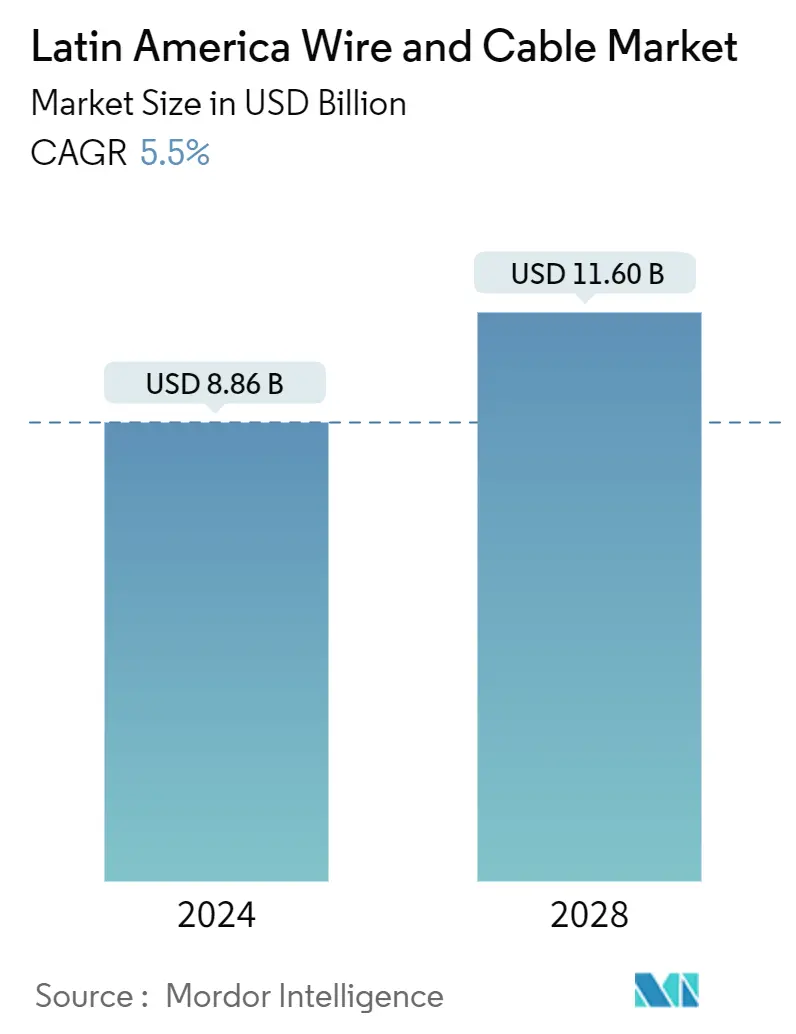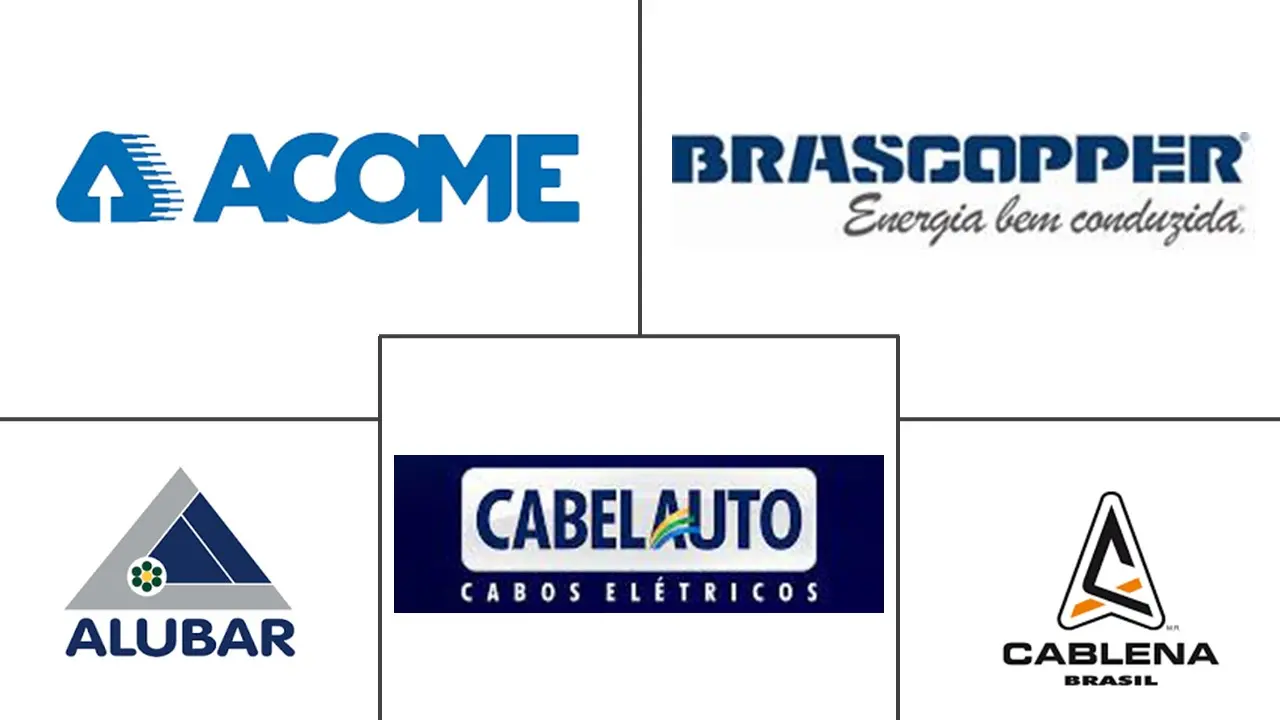Market Size of Latin America Wire And Cable Industry

| Study Period | 2019 - 2029 |
| Base Year For Estimation | 2023 |
| Market Size (2024) | USD 8.86 Billion |
| Market Size (2029) | USD 11.60 Billion |
| CAGR (2024 - 2028) | 5.50 % |
| Market Concentration | Low |
Major Players
*Disclaimer: Major Players sorted in no particular order |
Latin America Wire And Cable Market Analysis
The Latin America Wire And Cable Market size is estimated at USD 8.86 billion in 2024, and is expected to reach USD 11.60 billion by 2029, growing at a CAGR of 5.5% during the forecast period (2024-2029).
There is growing renewable energy production, increasing reserves in smart grid technology, and regional government initiatives to upgrade the distribution and transmission systems responsible for market proliferation. In the past few years, content and cloud providers have attempted to attract more customers and offer bandwidth-intensive services, increasing the popularity of submarine infrastructure. The lifespan of a submarine cable is expected to be 25 years.
- Cable manufacturing companies are significantly increasing fire-resistant cable production capacities to keep pace with the increasing need for construction products. Fire-resistant cables are designed to limit the propagation of flames. They have a sheet to determine the smoke and other toxic gases released. Such wires are designed for commercial buildings and wiring in large residential and manufacturing units.
- Latin America has experienced remarkable growth in infrastructure development, encompassing significant initiatives in electricity transmission and distribution, telecommunications, transportation, and building. These initiatives have increased demand for a wide range of wire and cable products, including power cables, communication cables, and building wires.
- The expected drivers for increased demand for wires and cables in the coming years include an increase in data demand, advancements in cable technology, a surge in demand for high-speed connectivity devices, the ongoing expansion of the communication sector, and government initiatives for complete electrification in the region.
- In addition, the rapid urbanization and population growth experienced in Latin American countries contribute to an escalated demand for housing, commercial structures, and urban infrastructure. Consequently, an increased necessity for electrical wiring, data transmission cables, and other cables utilized in building and development ventures arises.
- The fiber optic, power cable, and coaxial cable have numerous advantages, including higher bandwidth, low latency, and greater reliability and flexibility. However, their installation costs can often be quite high, running into thousands of dollars. The increasing need for connectivity in developing nations in Latin America represents a significant business opportunity for cable manufacturers. However, the installation of fiber optic cables poses certain operational challenges for market expansion.
Latin America Wire And Cable Industry Segmentation
A cable consists of more insulated wires wrapped in a single jacket that permits them to pass through, whereas a wire is a single conductor. The scope of the study includes various forms of wire and cable installations deployed in essential end-user facilities such as telecommunications, construction, and power infrastructure.
The Latin America wire and cable market is segmented into cable type (fiber optic cable, signal & control cable, power cable, others), end-user vertical (construction [residential & commercial], telecommunications [IT & telecom], power infrastructure [energy and power, automotive], others end-user verticals), by country (Mexico, Brazil, Argentina, rest of Latin America). The report offers market forecasts and size in value (USD) for all the above segments.
| By Cable Type | |
| Fiber Optic Cable | |
| Signal and Control Cable | |
| Power Cable | |
| Others |
| By End-user Vertical | |
| Construction (Residential and Commercial) | |
| Telecommunications (IT & Telecom) | |
| Power Infrastructure (Energy and Power, Automotive) | |
| Others End-user Verticals |
| By Country | |
| Mexico | |
| Brazil | |
| Argentina |
Latin America Wire And Cable Market Size Summary
The Latin America wire and cable market is poised for significant growth, driven by advancements in renewable energy production, smart grid technology, and government initiatives aimed at upgrading distribution and transmission systems. The region's infrastructure development, particularly in electricity transmission, telecommunications, and urbanization, has spurred demand for various wire and cable products. The increasing need for high-speed connectivity, fueled by the expansion of 5G networks and data centers, presents substantial opportunities for cable manufacturers. Despite the high installation costs of fiber optic cables, their advantages in terms of bandwidth, reliability, and security make them a preferred choice for modern telecommunications and data networking.
In Mexico, the market is experiencing robust growth due to investments in the automotive and manufacturing sectors, alongside the rising demand for IT and telecommunications solutions. The expansion of electrical networks and the construction of industrial parks further contribute to market proliferation. The proliferation of mobile devices and the demand for connected technologies, such as IoT and cloud-based services, are driving the need for new facilities. The market is characterized by fragmentation, with major players like Acome, Alubar, and Brascopper adopting strategic partnerships and acquisitions to enhance their offerings and maintain a competitive edge. Recent developments, such as strategic partnerships and infrastructure projects, underscore the dynamic nature of the market and its potential for continued expansion.
Latin America Wire And Cable Market Size - Table of Contents
-
1. MARKET INSIGHTS
-
1.1 Market Overview
-
1.2 Industry Attractiveness - Porter's Five Forces Analysis
-
1.2.1 Bargaining Power of Suppliers
-
1.2.2 Bargaining Power of Buyers
-
1.2.3 Threat of New Entrants
-
1.2.4 Threat of Substitutes
-
1.2.5 Intensity of Competitive Rivalry
-
-
1.3 Industry Value Chain Analysis
-
-
2. MARKET SEGMENTATION
-
2.1 By Cable Type
-
2.1.1 Fiber Optic Cable
-
2.1.2 Signal and Control Cable
-
2.1.3 Power Cable
-
2.1.4 Others
-
-
2.2 By End-user Vertical
-
2.2.1 Construction (Residential and Commercial)
-
2.2.2 Telecommunications (IT & Telecom)
-
2.2.3 Power Infrastructure (Energy and Power, Automotive)
-
2.2.4 Others End-user Verticals
-
-
2.3 By Country
-
2.3.1 Mexico
-
2.3.2 Brazil
-
2.3.3 Argentina
-
-
Latin America Wire And Cable Market Size FAQs
How big is the Latin America Wire And Cable Market?
The Latin America Wire And Cable Market size is expected to reach USD 8.86 billion in 2024 and grow at a CAGR of 5.5% to reach USD 11.60 billion by 2029.
What is the current Latin America Wire And Cable Market size?
In 2024, the Latin America Wire And Cable Market size is expected to reach USD 8.86 billion.

